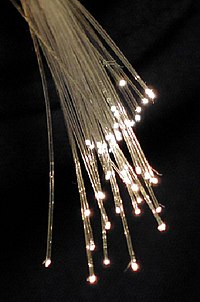
Photo from wikipedia
In this paper, the operating characteristic curves (OCCs) of optical code-division multiplexing (OCDM) technology for label switching of an optical packet-switching (OPS) network was evaluated. A node structure for processing… Click to show full abstract
In this paper, the operating characteristic curves (OCCs) of optical code-division multiplexing (OCDM) technology for label switching of an optical packet-switching (OPS) network was evaluated. A node structure for processing the packets, with spectral-amplitude-coding (SAC) labels, considering a balanced detector and an optical switch, was developed and modeled. The effects of decoding noises on the performance of both M-sequence and stuffed quadratic congruence (SQC) labeling systems were addressed. Hypothesis testing was applied to the decoder to investigate the results of label recognition. The null and alternative hypotheses were, respectively, defined as a decoder receiving the matching and mismatching labels. Due to the noise effects, the decoder output may not reflect the label status correctly. Type I error occurs when the null hypothesis is true while accepting the alternative one. Type II error occurs when the alternative hypothesis is true while accepting the null one. Analytic equations of both errors were given, considering a desired packet that was missed and an undesired packet shown in a switched path. The trade-off between these two errors, regarding the decoder threshold, was demonstrated in operating characteristic curves (OCCs). A better OCC could be found when a packet had more labeled payload bits, or when the utilized label code had a lower auto-to-cross-correlation ratio.
Journal Title: Photonics
Year Published: 2023
Link to full text (if available)
Share on Social Media: Sign Up to like & get
recommendations!